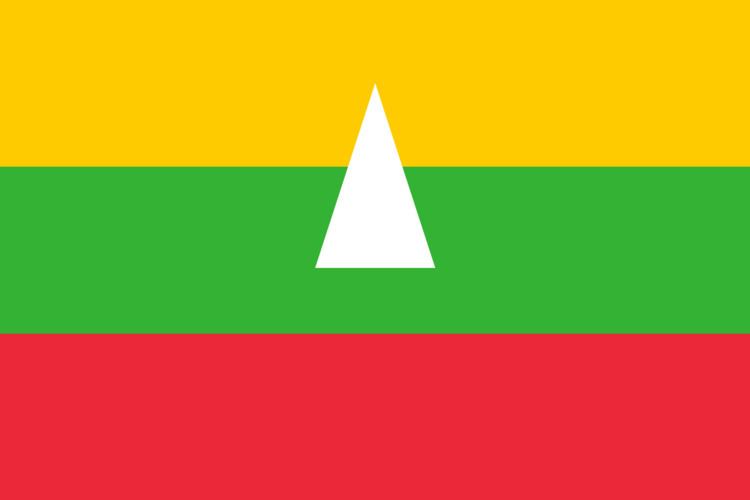Population 53.26 million (2013) Population growth rate 0.9% annual change (2013) | Life expectancy 64.93 years (2012) | |
 | ||
Fertility rate 1.96 births per woman (2012) | ||
The following is an overview of the demographics of Myanmar (also known as Burma), including statistics such as population, ethnicity, language, education level and religious affiliation.
Contents
- Map of Myanmar Burma
- 1983 census
- 2014 census
- Vital statistics
- Births and deaths
- Fertility and births
- Structure of the population
- Government classifications
- Language
- CIA World Factbook demographic statistics
- Age structure
- Median age
- Population growth rate
- Urbanisation
- Human sex ratios
- Life expectancy
- Literacy
- Education expenditures
- References
Map of Myanmar (Burma)
1983 census
At the time of the 1983 census in Burma, as of 31 March 1983, the population was 35,442,972. As of July 2012, this was estimated by the CIA World Factbook to have increased to 60,584,650. Other estimates put place the total population at around 60 million. China's People's Daily reported that Burma had a census in 2007, and at the end of 2009 has 59.2 million people, and growing at 2% annually. with exception for Cyclone Nargis in 2008. Most of these estimates have indeed overlooked the demographic changes that were at work since the 1970s in the country.
Britain-based human rights agencies place the population as high as 70 million. Estimates for the country explicitly take into account the effects of excess mortality due to AIDS. This can result in lower life expectancy, higher infant mortality and death rates, lower population and growth rates, and changes in the distribution of population by age and sex than would otherwise be expected.
No trustworthy census has occurred since the 1930s. In the 1940s, the detailed census results were destroyed during the Japanese invasion of 1942. Census results after that time have been flawed by civil wars and a series of military governments. The census in 1983 occurred at a time when parts of the country were controlled by insurgent groups and inaccessible to the government.
2014 census
The Provisional results of the 2014 census show that the total population of Myanmar is 51,419,420—a population well below the official estimates of more than 60 million. This total population includes 50,213,067 persons counted during the census and an estimated 1,206,353 persons in parts of northern Rakhine State, Kachin State and Kayin State who were not counted. More females (51.8%) were counted than males (48.2%). People who were out of the country at the time of the census are not included in these figures.
The provisional census results indicated that there were 10,889,348 households in Myanmar. On average, 4.4 people lived in each household in the country. The average household size was highest in Kachin State and Chin State at 5.1. The lowest household sizes were observed in Ayeyawady Region, Bago Region, Magway Region and Naypyidaw Union Territory, each at 4.1.
Vital statistics
Burma has a low fertility rate (2.23 in 2011), slightly above replacement level, especially as compared to other Southeast Asian countries of similar economic standing, like Cambodia (3.18) and Laos (4.41), representing a significant decline from 4.7 in 1983 to 2.4 in 2001, despite the absence of any national population policy.
The fertility rate is much pronouncedly lower in urban areas. This is attributed to extreme delays in marriage (almost unparalleled in the region, with the exception of developed countries), the prevalence of illegal abortions, and the high proportion of single, unmarried women of reproductive age (with 25.9% of women aged 30–34 and 33.1% of men and women aged 25–34 single).
These patterns stem from several cultural and economic dynamics. The first is economic hardship, which results in the delay of marriage and family-building (the average age of marriage in Burma is 27.5 for men, 26.4 for women). The second is the social acceptability of celibacy among the Burmese, who are predominantly Buddhist and value celibacy as a means of spiritual development.
Births and deaths
Births and deaths
Fertility and births
Total Fertility Rate (TFR) and Crude Birth Rate (CBR):
Crude Birth Rate (CBR), Total Fertility Rate (TFR), and Total Marital Fertility Rate (TMFR) by region (2014 Myanmar Population and Housing Census):
Structure of the population
Structure of the population (01.10.2012) (Estimates) :
Structure of the population (2014) (Census) Population - 51 486 253, enumereted - 50 279 900 :
Government classifications
The Burmese government identifies eight major national ethnic races (which comprise 135 "distinct" ethnic groups), which include the Bamar (68%), Shan (9%), Kayin (7%), Rakhine (4%), Mon (2%), Kayah, and Kachin. However, the government classification system is flawed, because it groups ethnic groups under ethnic races by geography, rather than by linguistic or genetic similarity (e.g. the Kokang are under the Shan ethnic race, although they are ethnic Chinese).
Unrecognised ethnic groups include Burmese Indians and Burmese Chinese, who form 2% and 3% of the population respectively. The remaining 5% of the population belong to small ethnic groups such as the remnants of the Anglo-Burmese and Anglo-Indian communities, as well as the Lisu, Rawang, Naga, Padaung, Moken, and many minorities across Shan State.
Language
The official language and primary medium of instruction of Burma is Burmese (65%). Multiple languages are spoken in Burma, and include Shan (6.4%), Karen (5.2%), Kachin (1.8%), Chin (1.6%), Mon (1.5%), and Rakhine (1.5%). English is also spoken, particularly by the educated urban elite, and is the secondary language learnt in government schools.
CIA World Factbook demographic statistics
The following demographic statistics are from the CIA World Factbook, unless otherwise indicated.
Age structure
Median age
Population growth rate
1.07% (2011 est.)
Urbanisation
Human sex ratios
Life expectancy
Literacy
(age 15 and over can read and write, official statistics)
Education expenditures
1.2% of total GDP (2001)
